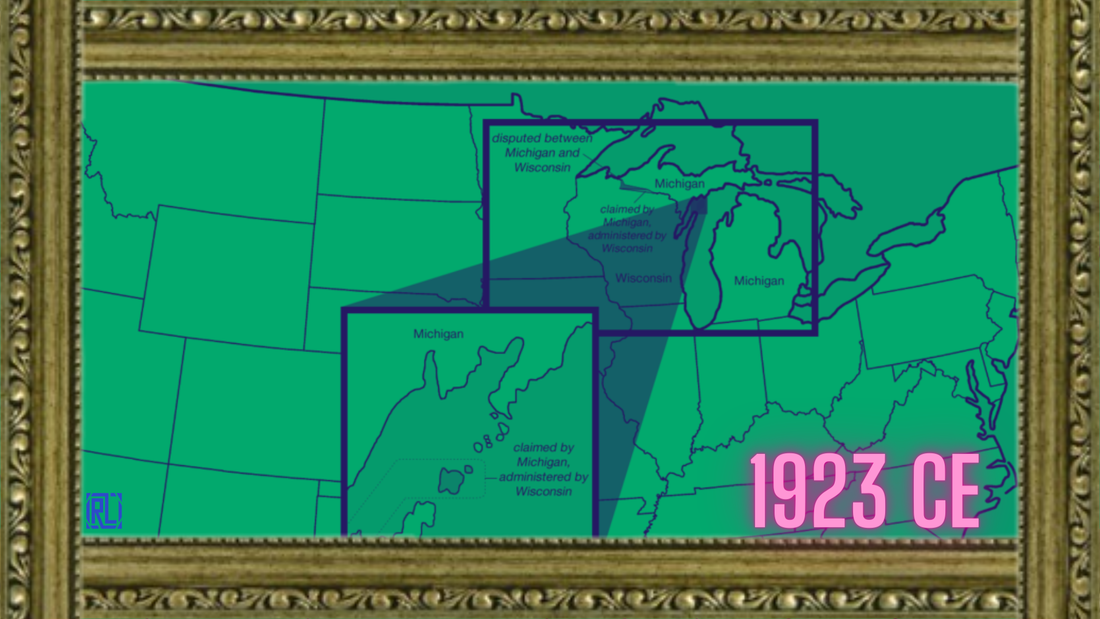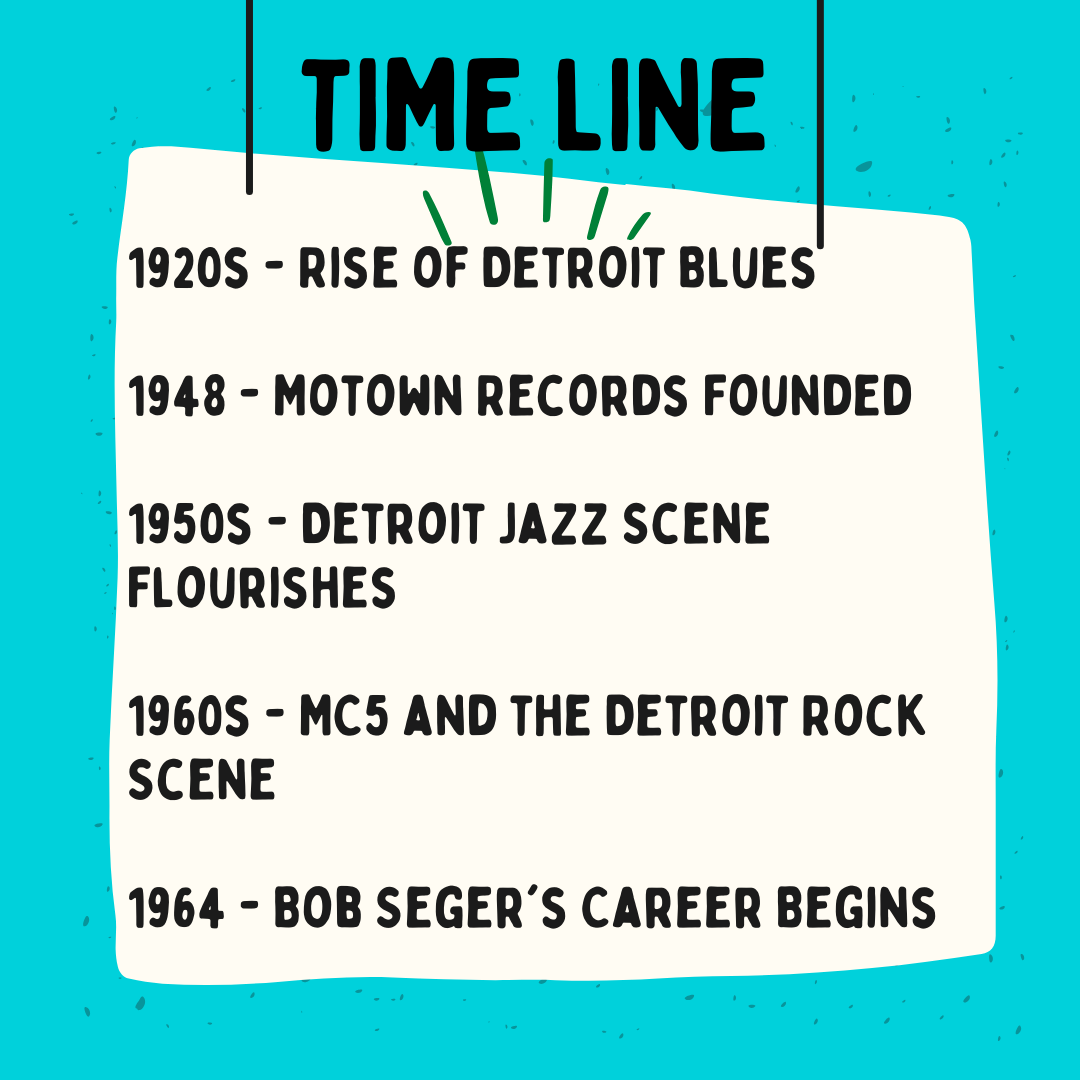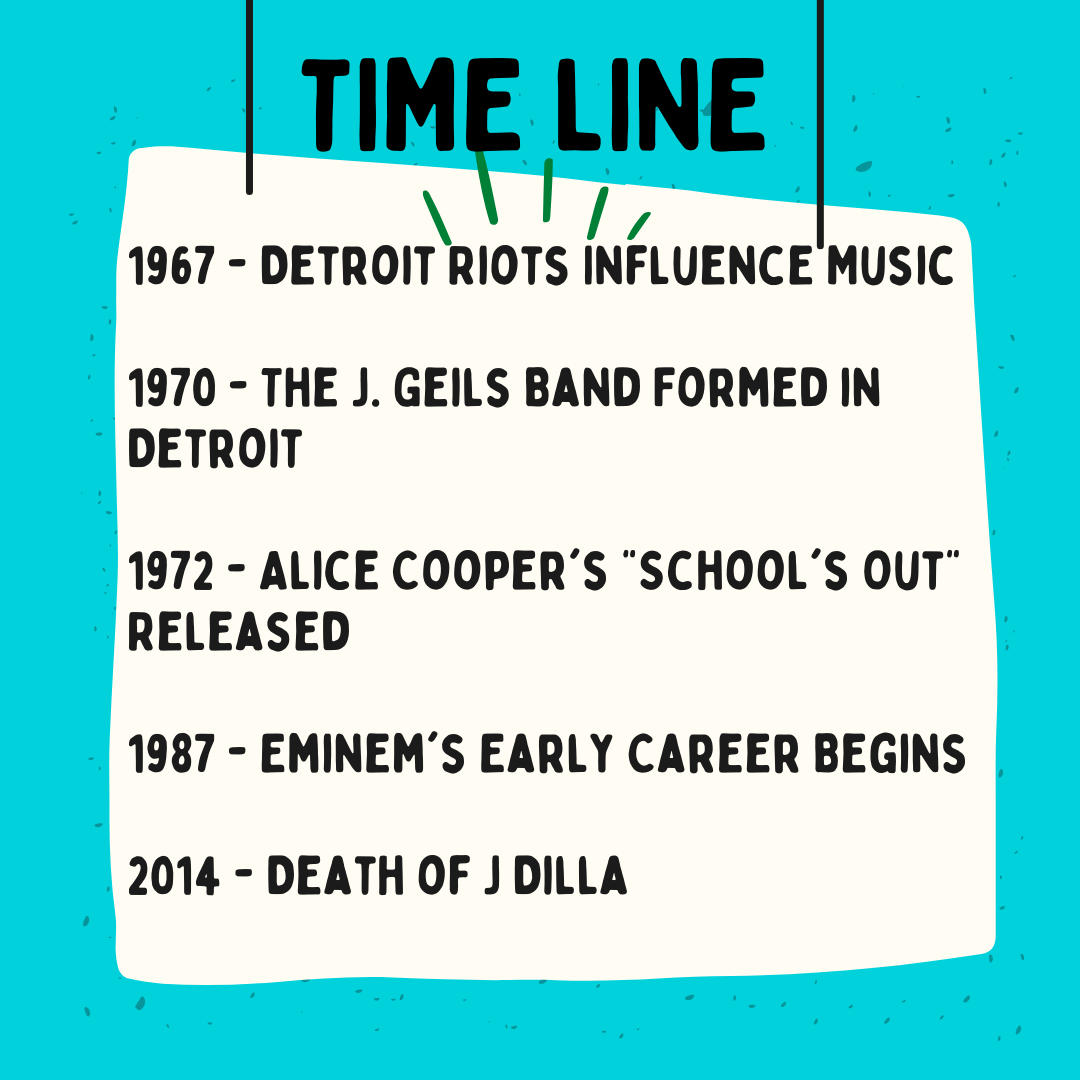Module Seven: Motown Melodies
In the depths of Michigan's urban sprawl, where the scent of industry mingles with shattered aspirations, the state's musical saga unfolds, a symphony woven with threads of chaos. Beyond the polished exterior of Motown lies a narrative steeped in exploitation, defiance, and societal upheaval. Let's delve into Motown, the brainchild of Berry Gordy Jr., who straddled the line between visionary and capitalist. Anthems from Motown Records emerged, reverberating from inner-city alleys to the highest echelons of power. Yet, behind the glamour, a darker truth lurked.
The Motown machinery, while appearing seamless, harbored a shadowy underbelly. Artists, the heartbeat of Motown, found themselves ensnared in Gordy's game. Financial disputes and legal wrangling tainted the glittering facade, a reminder that even the most captivating melodies bore the stain of capitalism. Turning to Detroit's rebellious rock scene, bands like The Stooges and MC5 birthed a sound born of frustration and defiance. Their music became the anthem of unrest, reaching its crescendo during the 1967 riots.
The riots, a visceral expression of societal tensions, saw music transform into a weapon of rebellion. Detroit's rock scene became the soundtrack of defiance, a cacophony of dissent echoing through the streets. Yet, Michigan's musical tapestry extends beyond exploitation and rebellion. Jazz resonates through Detroit's alleyways, embodying the city's diverse soul. Icons like Duke Ellington and Ella Fitzgerald left their mark, their melodies mingling with the city's pulse.
And folk, the voice of the disenfranchised, found solace in Michigan's embrace. Against urban decay, troubadours strummed their guitars, weaving tales of resilience. Unraveling Michigan's musical legacy reveals the contradictions inherent in the human experience. Motown's highs juxtaposed with rock and roll's defiance, jazz's sophistication alongside folk's raw authenticity—a chaotic ballet of sound. In an age where music remains a catalyst for change, studying Michigan's musical tapestry becomes an act of rebellion—rejecting sanitized narratives in favor of authenticity. So, pick up your instrument, lace up your jazz shoes, and traverse Michigan's musical landscape, where melody intertwines with bitter truths.
THE RUNDOWN
QUESTIONS
The Motown machinery, while appearing seamless, harbored a shadowy underbelly. Artists, the heartbeat of Motown, found themselves ensnared in Gordy's game. Financial disputes and legal wrangling tainted the glittering facade, a reminder that even the most captivating melodies bore the stain of capitalism. Turning to Detroit's rebellious rock scene, bands like The Stooges and MC5 birthed a sound born of frustration and defiance. Their music became the anthem of unrest, reaching its crescendo during the 1967 riots.
The riots, a visceral expression of societal tensions, saw music transform into a weapon of rebellion. Detroit's rock scene became the soundtrack of defiance, a cacophony of dissent echoing through the streets. Yet, Michigan's musical tapestry extends beyond exploitation and rebellion. Jazz resonates through Detroit's alleyways, embodying the city's diverse soul. Icons like Duke Ellington and Ella Fitzgerald left their mark, their melodies mingling with the city's pulse.
And folk, the voice of the disenfranchised, found solace in Michigan's embrace. Against urban decay, troubadours strummed their guitars, weaving tales of resilience. Unraveling Michigan's musical legacy reveals the contradictions inherent in the human experience. Motown's highs juxtaposed with rock and roll's defiance, jazz's sophistication alongside folk's raw authenticity—a chaotic ballet of sound. In an age where music remains a catalyst for change, studying Michigan's musical tapestry becomes an act of rebellion—rejecting sanitized narratives in favor of authenticity. So, pick up your instrument, lace up your jazz shoes, and traverse Michigan's musical landscape, where melody intertwines with bitter truths.
THE RUNDOWN
- Michigan's musical heritage, embracing diverse genres, weaves through landscapes and industries.
- Indigenous roots underscore the historical significance of the state's musical journey.
- Motown Records, established in Detroit in 1959, shattered racial barriers and left an indelible mark on the Civil Rights Movement.
- Challenges encountered by Motown, such as artist exploitation and shifts in sound authenticity, mirror industry dynamics.
- Detroit's pivotal role in rock and roll's evolution resonates with socio-political turbulence.
- The 1967 Detroit riots spotlighted racial tensions and economic disparities, reflecting broader societal issues.
QUESTIONS
- What do you think about Motown's impact on music history? Do you think the way some artists were treated unfairly affects how we see Motown's importance?
- How did rock music, especially in Detroit during the 1967 riots, stand up against what was happening in society? How did it help people express their feelings?
- How did different types of music, like jazz, folk, and rock, help change things in society? Can you find similarities in how they spoke out against problems?
#7 Historiography is Important and is Never Stagnant
In the intricate tapestry of human chronicles, historiography emerges as the voyeuristic aperture through which we peer into antiquity, albeit clouded by the biases and distortions inherent in subjective interpretation. It resembles deciphering hieroglyphs through the haze of intoxication; while the essence may be discerned, the finer details remain obscured.
Imagine this: Herodotus, the original chronicler, striding through ancient Greece with an air of ownership, weaving narratives of deities, monsters, and drama rivaling the climax of "Keeping Up with the Spartans." Skip ahead a few millennia, and Howard Zinn detonates truth bombs like confetti at a rebellion-themed soirée, unsettling historical narratives akin to a bartender vigorously shaking a cocktail.
Yet, let's delve into revisionism, shall we? It's akin to hitting the "undo" button on history's greatest hits compilation. Consider Native American history: once relegated to footnotes by those viewing Columbus as merely a geographically befuddled Italian, it now basks in the limelight. Thanks to movements like the American Indian Movement and voices like Vine Deloria Jr., a fresh perspective emerges that refuses to gloss over centuries of oppression akin to a poor Tinder profile.
Historiography is not merely about stirring the pot but infusing zest into an otherwise bland concoction. Think of it as a culinary experiment gone deliciously awry, with historians tossing in new ingredients akin to contestants on "Chopped: Ancient Civilizations Edition." Case in point: the Dead Sea Scrolls. Forget Indiana Jones; these artifacts are true treasures, offering a tantalizing glimpse into the lives of ancient Essenes and igniting debates fiercer than a chili-eating contest.
However, let's not deceive ourselves; historiography harbors biases like street vendors peddling counterfeit wares. Recall the Cold War-era scholars who perceived communists lurking behind every corner. It turns out that impartiality wasn't their forte. And the Nazi propaganda machine? It churned out historical narratives akin to Goebbels-approved bedtime tales.
In today's era of misinformation and alternative truths, historiography assumes unprecedented significance. It is the antidote to historical forgetfulness, the shield against cognitive lethargy. By acknowledging our biases and scrutinizing the narratives we ingest, we inch closer to an honest comprehension of the past—one that confronts human existence's messy, intricate reality. So here's to historiography, the unsung hero of the annals. Without it, we'd flounder in a sea of half-truths and falsehoods, destined to replay the errors of yesteryears like a broken record. Here's to reshaping history, one revision at a time.
RUNDOWN
STATE OF THE STATE
Imagine this: Herodotus, the original chronicler, striding through ancient Greece with an air of ownership, weaving narratives of deities, monsters, and drama rivaling the climax of "Keeping Up with the Spartans." Skip ahead a few millennia, and Howard Zinn detonates truth bombs like confetti at a rebellion-themed soirée, unsettling historical narratives akin to a bartender vigorously shaking a cocktail.
Yet, let's delve into revisionism, shall we? It's akin to hitting the "undo" button on history's greatest hits compilation. Consider Native American history: once relegated to footnotes by those viewing Columbus as merely a geographically befuddled Italian, it now basks in the limelight. Thanks to movements like the American Indian Movement and voices like Vine Deloria Jr., a fresh perspective emerges that refuses to gloss over centuries of oppression akin to a poor Tinder profile.
Historiography is not merely about stirring the pot but infusing zest into an otherwise bland concoction. Think of it as a culinary experiment gone deliciously awry, with historians tossing in new ingredients akin to contestants on "Chopped: Ancient Civilizations Edition." Case in point: the Dead Sea Scrolls. Forget Indiana Jones; these artifacts are true treasures, offering a tantalizing glimpse into the lives of ancient Essenes and igniting debates fiercer than a chili-eating contest.
However, let's not deceive ourselves; historiography harbors biases like street vendors peddling counterfeit wares. Recall the Cold War-era scholars who perceived communists lurking behind every corner. It turns out that impartiality wasn't their forte. And the Nazi propaganda machine? It churned out historical narratives akin to Goebbels-approved bedtime tales.
In today's era of misinformation and alternative truths, historiography assumes unprecedented significance. It is the antidote to historical forgetfulness, the shield against cognitive lethargy. By acknowledging our biases and scrutinizing the narratives we ingest, we inch closer to an honest comprehension of the past—one that confronts human existence's messy, intricate reality. So here's to historiography, the unsung hero of the annals. Without it, we'd flounder in a sea of half-truths and falsehoods, destined to replay the errors of yesteryears like a broken record. Here's to reshaping history, one revision at a time.
RUNDOWN
- Historiography, the study of history, helps us understand past mysteries.
- Like history, historiography changes over time, shaping how we see the past.
- Ancient and modern historians offer different perspectives on historical events.
- The internet changed how we research history, making information easier to find.
- "Revisionist" approaches challenge biased views, like rethinking Native American history.
- Historians uncover hidden treasures, like the enlightening Dead Sea Scrolls.
STATE OF THE STATE
HIGHLIGHTS
We've got some fine classroom lectures coming your way, all courtesy of the RPTM podcast. These lectures will take you on a wild ride through history, exploring everything from ancient civilizations and epic battles to scientific breakthroughs and artistic revolutions. The podcast will guide you through each lecture with its no-nonsense, straight-talking style, using various sources to give you the lowdown on each topic. You won't find any fancy-pants jargon or convoluted theories here, just plain and straightforward explanations anyone can understand. So sit back and prepare to soak up some knowledge.
LECTURES
LECTURES
- UNDER CONSTRUCTION!
READING
This class utilizes the following textbook:
Hathaway, Richard J. Michigan Visions of Our Past. United States Of America: Michigan State University Press, 1989.
"Michigan: Visions of Our Past" is an exhilarating adventure through the state's eventful history, led by scholars like Hathaway wielding the tools of the past. This collection reads like a diverse assortment of exciting stories and surprising revelations, providing a non-linear exploration of Michigan's struggle with its identity – be it navigating labor disputes, economic ups and downs, or the enduring conflict between religion and education. The book, resembling more of a mind-bending trip than a traditional history lesson, reflects Michigan's tumultuous history, encouraging readers to recognize that history is not merely a forgotten tome but a guidebook for the state's uncertain future. In this unconventional narrative, Michigan's history unfolds as a disorderly, absurd spectacle – a turbulent, unpredictable journey that embraces idiosyncrasies, confronts challenges, and invites everyone to the lively celebration of the past.
- Hathaway Chapter Two: "Unconquered Nations: The Native Peoples of Michigan"
This class utilizes the following textbook:
Hathaway, Richard J. Michigan Visions of Our Past. United States Of America: Michigan State University Press, 1989.
"Michigan: Visions of Our Past" is an exhilarating adventure through the state's eventful history, led by scholars like Hathaway wielding the tools of the past. This collection reads like a diverse assortment of exciting stories and surprising revelations, providing a non-linear exploration of Michigan's struggle with its identity – be it navigating labor disputes, economic ups and downs, or the enduring conflict between religion and education. The book, resembling more of a mind-bending trip than a traditional history lesson, reflects Michigan's tumultuous history, encouraging readers to recognize that history is not merely a forgotten tome but a guidebook for the state's uncertain future. In this unconventional narrative, Michigan's history unfolds as a disorderly, absurd spectacle – a turbulent, unpredictable journey that embraces idiosyncrasies, confronts challenges, and invites everyone to the lively celebration of the past.
Howard Zinn was a historian, writer, and political activist known for his critical analysis of American history. He is particularly well-known for his counter-narrative to traditional American history accounts and highlights marginalized groups' experiences and perspectives. Zinn's work is often associated with social history and is known for his Marxist and socialist views. Larry Schweikart is also a historian, but his work and perspective are often considered more conservative. Schweikart's work is often associated with military history, and he is known for his support of free-market economics and limited government. Overall, Zinn and Schweikart have different perspectives on various historical issues and events and may interpret historical events and phenomena differently. Occasionally, we will also look at Thaddeus Russell, a historian, author, and academic. Russell has written extensively on the history of social and cultural change, and his work focuses on how marginalized and oppressed groups have challenged and transformed mainstream culture. Russell is known for his unconventional and controversial ideas, and his work has been praised for its originality and provocative nature.
My classes utilize both Howard Zinn's A People's History of the United States and Larry Schweikart's Patriot's History of the United States, mostly in excerpts posted to the modules.
My classes utilize both Howard Zinn's A People's History of the United States and Larry Schweikart's Patriot's History of the United States, mostly in excerpts posted to the modules.

Zinn, A People's History of the United States
"...The most important thing about dress in the cultural change of the (1960s) was the greater informality. For women it was a continuation of the historic feminist movement's insistence on discarding of 'feminine,' hampering clothes. Many women stopped wearing bras. The restrictive 'girdle'-almost a uniform of the forties and fifties-became rare. Young men and women dressed more nearly alike, in jeans, in discarded army uniforms. Men stopped wearing neckties, women of all ages wore pants more often-unspoken homage to Amelia Bloomer.
There was a new popular music of protest. Pete Seeger had been singing protest songs since the forties, but now he came into his own, his audiences much larger. Bob Dylan and Joan Baez, singing not only protest songs, but songs reflecting the new abandon, the new culture,
became popular idols. A middle-aged woman on the West Coast, Malvina Reynolds, wrote and sang songs that fit her socialist thinking and her libertarian spirit, as well as her critique of the modern commercial culture. Everybody now, she sang, lived in 'little boxes' and they 'all came out just the same.'
Bob Dylan was a phenomenon unto himself: powerful songs of protest, persona] songs of freedom and self-expression. In an angry song, 'Masters of War,' he hopes that one day they will the and he will follow their casket "in the pale afternoon.' 'A Hard Rain's A-Gonna Fall' recounts the terrible stories of the last decades, of starvation and war, and tears, and dead ponies, and poisoned waters, and damp, dirty prisons-'It's a hard rain's a-gonna fall.' Dylan sang a bitter antiwar song, 'With God on Our Side,' and one about the killer of the black activist Medgar Evers, 'Only a Pawn in Their Game.' He offered a challenge to the old, hope to the new, for 'The Times They Are A-Changin'..."
"...The most important thing about dress in the cultural change of the (1960s) was the greater informality. For women it was a continuation of the historic feminist movement's insistence on discarding of 'feminine,' hampering clothes. Many women stopped wearing bras. The restrictive 'girdle'-almost a uniform of the forties and fifties-became rare. Young men and women dressed more nearly alike, in jeans, in discarded army uniforms. Men stopped wearing neckties, women of all ages wore pants more often-unspoken homage to Amelia Bloomer.
There was a new popular music of protest. Pete Seeger had been singing protest songs since the forties, but now he came into his own, his audiences much larger. Bob Dylan and Joan Baez, singing not only protest songs, but songs reflecting the new abandon, the new culture,
became popular idols. A middle-aged woman on the West Coast, Malvina Reynolds, wrote and sang songs that fit her socialist thinking and her libertarian spirit, as well as her critique of the modern commercial culture. Everybody now, she sang, lived in 'little boxes' and they 'all came out just the same.'
Bob Dylan was a phenomenon unto himself: powerful songs of protest, persona] songs of freedom and self-expression. In an angry song, 'Masters of War,' he hopes that one day they will the and he will follow their casket "in the pale afternoon.' 'A Hard Rain's A-Gonna Fall' recounts the terrible stories of the last decades, of starvation and war, and tears, and dead ponies, and poisoned waters, and damp, dirty prisons-'It's a hard rain's a-gonna fall.' Dylan sang a bitter antiwar song, 'With God on Our Side,' and one about the killer of the black activist Medgar Evers, 'Only a Pawn in Their Game.' He offered a challenge to the old, hope to the new, for 'The Times They Are A-Changin'..."

Larry Schweikart, A Patriot's History of the United States
...Colonial art, architecture, drama, and music also reflected American practicality and democracy spawned in a frontier environment. Artists found their only market for paintings in portraiture and, later, patriot art. Talented painters like John Singleton Copley and Benjamin West made their living painting the likenesses of colonial merchants, planters, and their families; eventually both sailed for Europe to pursue purer artistic endeavors. American architecture never soared to magnificence, though a few public buildings, colleges, churches, and private homes reflected an aesthetic influenced by classical motifs and Georgian styles. Drama, too, struggled. Puritan Massachusetts prohibited theater shows (the “Devil’s Workshop”), whereas thespians in Philadelphia, Williamsburg, and Charleston performed amateurish productions of Shakespeare and contemporary English dramas. Not until Royall Tyler tapped the patriot theme (and the comic potential of the Yankee archetype) in his 1789 production of The Contrast would American playwrights finally discover their niche, somewhere between high and low art.
In eighteenth century Charleston, Boston, and Philadelphia, the upper classes could occasionally hear Bach and Mozart performed by professional orchestras. Most musical endeavor, however, was applied to religion, where church hymns were sung a cappella and, occasionally, to the accompaniment of a church organ. Americans customized and syncopated hymns, greatly aggravating pious English churchmen. Reflecting the most predominant musical influence in colonial America, the folk idiom of Anglo, Celtic, and African emigrants, American music already had coalesced into a base upon which new genres of church and secular music—gospel, field songs, and white folk ballads—would ultimately emerge..."
...Colonial art, architecture, drama, and music also reflected American practicality and democracy spawned in a frontier environment. Artists found their only market for paintings in portraiture and, later, patriot art. Talented painters like John Singleton Copley and Benjamin West made their living painting the likenesses of colonial merchants, planters, and their families; eventually both sailed for Europe to pursue purer artistic endeavors. American architecture never soared to magnificence, though a few public buildings, colleges, churches, and private homes reflected an aesthetic influenced by classical motifs and Georgian styles. Drama, too, struggled. Puritan Massachusetts prohibited theater shows (the “Devil’s Workshop”), whereas thespians in Philadelphia, Williamsburg, and Charleston performed amateurish productions of Shakespeare and contemporary English dramas. Not until Royall Tyler tapped the patriot theme (and the comic potential of the Yankee archetype) in his 1789 production of The Contrast would American playwrights finally discover their niche, somewhere between high and low art.
In eighteenth century Charleston, Boston, and Philadelphia, the upper classes could occasionally hear Bach and Mozart performed by professional orchestras. Most musical endeavor, however, was applied to religion, where church hymns were sung a cappella and, occasionally, to the accompaniment of a church organ. Americans customized and syncopated hymns, greatly aggravating pious English churchmen. Reflecting the most predominant musical influence in colonial America, the folk idiom of Anglo, Celtic, and African emigrants, American music already had coalesced into a base upon which new genres of church and secular music—gospel, field songs, and white folk ballads—would ultimately emerge..."

Thaddeus Russell, A Renegade History of the United States
"."... After World War II, Soviet soldiers brought the virus home from the western front. It soon infected large portions of the Soviet population, then spread to other Eastern Bloc countries. Within a few years, the Communist Party leadership feared it would destroy the socialist fatherland from within. But it was not a biological disease that threatened Communism. Soviet Premier Joseph Stalin and his commissars called it an “amoral infection” in the minds of Soviet youth. It was 'American primitivism,' 'capitalist cultural imperialism,' and 'bourgeois cosmopolitanism.' But it was really American renegade culture.
In 1946, soon after Stalin’s chief aide Andrei Zhdanov warned that jazz would 'poison the consciousness of the masses,' the Central Committee of the Communist Party ordered all state orchestras to stop playing the music. Also banned were saxophones, wah-wah trumpet mutes, the plucking of bass strings, the deliberate lowering of tones to create 'blue notes,' and the playing of drums with too much rhythm. Brigades of music patrols monitored theaters and dance halls to ensure that nothing jazzy was being played. Couples caught dancing anything other than the waltz, the polka, or Russian folk dances were subject to arrest. Members of jazz bands were rounded up and sent to Siberian prisons or exiled to remote cities, where they were supposed to undergo 'rehabilitation.'
Soviet authorities were right to fear jazz, but they could not stop it. Bootleg recordings were sold by the millions on the black market. Stiliagi, or 'style hunters,' appeared on the streets of all the major cities in the Soviet bloc, wearing zoot suits and ducktails if they were male or tight dresses—'stretched tightly over their figures to the point of indecency,' according to one state-run Soviet newspaper—and bouffant hairdos if they were female. They refused to work and loved to drink, 'hang out,' read American comic books, and listen to African American music. With little access to American-made products, the stiliagi were forced to re-create them on their own. To make flashy, multicolored ties, they literally painted over their drab, state-issued ties, or affixed to them American cigarette packages. Because there were no hairstylists behind the Iron Curtain who could or would give them the look of their American idols, the style hunters used heated metal rods on one another’s hair. So, many sported not only fashionable ducktails but also burns on their necks. Instead of American chewing gum, many chewed paraffin wax. They smuggled as many of the real sounds of renegade America as they could but were forced to copy them in an ingenious way. A jazz-loving Soviet medical student discovered that he could inscribe sound grooves on the surface of X-ray plates, and invented a machine that allowed him to produce low-quality but sufficient copies of music recordings. From there, the stiliagi used the technique to take over the black market in American music. Swing and boogie-woogie were early favorites, then bebop and rhythm and blues.
Every nation of the Eastern Bloc had its own stiliagi. In Poland, they were the bikiniarze. In Hungary, they were the jampec. And in Czechoslovakia, pásek overran the streets. When the police in these countries didn’t arrest the renegades, they gave them impromptu street haircuts or slashed their clothes..."
"."... After World War II, Soviet soldiers brought the virus home from the western front. It soon infected large portions of the Soviet population, then spread to other Eastern Bloc countries. Within a few years, the Communist Party leadership feared it would destroy the socialist fatherland from within. But it was not a biological disease that threatened Communism. Soviet Premier Joseph Stalin and his commissars called it an “amoral infection” in the minds of Soviet youth. It was 'American primitivism,' 'capitalist cultural imperialism,' and 'bourgeois cosmopolitanism.' But it was really American renegade culture.
In 1946, soon after Stalin’s chief aide Andrei Zhdanov warned that jazz would 'poison the consciousness of the masses,' the Central Committee of the Communist Party ordered all state orchestras to stop playing the music. Also banned were saxophones, wah-wah trumpet mutes, the plucking of bass strings, the deliberate lowering of tones to create 'blue notes,' and the playing of drums with too much rhythm. Brigades of music patrols monitored theaters and dance halls to ensure that nothing jazzy was being played. Couples caught dancing anything other than the waltz, the polka, or Russian folk dances were subject to arrest. Members of jazz bands were rounded up and sent to Siberian prisons or exiled to remote cities, where they were supposed to undergo 'rehabilitation.'
Soviet authorities were right to fear jazz, but they could not stop it. Bootleg recordings were sold by the millions on the black market. Stiliagi, or 'style hunters,' appeared on the streets of all the major cities in the Soviet bloc, wearing zoot suits and ducktails if they were male or tight dresses—'stretched tightly over their figures to the point of indecency,' according to one state-run Soviet newspaper—and bouffant hairdos if they were female. They refused to work and loved to drink, 'hang out,' read American comic books, and listen to African American music. With little access to American-made products, the stiliagi were forced to re-create them on their own. To make flashy, multicolored ties, they literally painted over their drab, state-issued ties, or affixed to them American cigarette packages. Because there were no hairstylists behind the Iron Curtain who could or would give them the look of their American idols, the style hunters used heated metal rods on one another’s hair. So, many sported not only fashionable ducktails but also burns on their necks. Instead of American chewing gum, many chewed paraffin wax. They smuggled as many of the real sounds of renegade America as they could but were forced to copy them in an ingenious way. A jazz-loving Soviet medical student discovered that he could inscribe sound grooves on the surface of X-ray plates, and invented a machine that allowed him to produce low-quality but sufficient copies of music recordings. From there, the stiliagi used the technique to take over the black market in American music. Swing and boogie-woogie were early favorites, then bebop and rhythm and blues.
Every nation of the Eastern Bloc had its own stiliagi. In Poland, they were the bikiniarze. In Hungary, they were the jampec. And in Czechoslovakia, pásek overran the streets. When the police in these countries didn’t arrest the renegades, they gave them impromptu street haircuts or slashed their clothes..."
In the sprawling narrative of Michigan's musical journey, it's impossible not to imagine the state as a vibrant theater where the drama of history unfolds in unpredictable rhythms. Think of it: a landscape where colonial elegance collides with post-war defiance, where John Coltrane's saxophone notes blend with the spectral strokes of John Singleton Copley's brush. Michigan transcends being a mere geographical entity; it emerges as a muse, a passionate lover, and a chaotic conductor orchestrating a symphony of cultural diversity.
Let's rewind to an era of powdered wigs and America's youthful rebellion against the monarchic rule. In colonial Michigan, art served as an aesthetic expression and a declaration of independence against British rule. Enter Copley and West, wielding brushes like weapons, painting scenes of patriotic fervor. They weren't just artists; they were revolutionaries wielding palettes and pigments. Amidst the architectural nods to classical traditions, Michigan pulsated with the eclectic fusion of Anglo, Celtic, and African influences, akin to a masterful blend crafted by a skilled bartender.
But let's not romanticize the past excessively. Colonial Michigan was rife with its conflicts, both onstage and off. The quest for a unique theatrical identity was as challenging as a counterfeit coin, with playwrights like Royall Tyler striving to infuse Yankee spirit while grappling with the shadows of European dominance. It was a cultural struggle, and Michigan was embroiled, seeking to carve its distinct voice amidst the cacophony.
Fast forward to the aftermath of World War II, and Michigan faces new challenges, particularly the paranoia of the Red Scare and its aversion to anything remotely jazzy. Jazz symbolized not just music but a potent blend of freedom, rebellion, and rhythm, a concoction that authorities feared. Yet jazz, defiant as ever, refused to be silenced. Underground clubs became battlegrounds where rebels fought for the right to swing despite government crackdowns.
Indeed, there were setbacks: bans, censorship, and the occasional jazz artist blocked by authorities. Yet Michigan remained resilient, a bastion of musical defiance amidst conformity. Figures like Coltrane and Davis sought refuge in the smoky enclaves of Detroit, where music mirrored the city's rebellious spirit.
The lesson from this spirited narrative? Michigan's musical saga isn't a mere footnote in history but a testament to art's ability to transcend boundaries, challenge oppression, and, above all, stir the soul and provoke defiance. Here's to Michigan, where history sings, dances, and asserts itself with rebellious fervor.
THE RUNDOWN
QUESTIONS
Let's rewind to an era of powdered wigs and America's youthful rebellion against the monarchic rule. In colonial Michigan, art served as an aesthetic expression and a declaration of independence against British rule. Enter Copley and West, wielding brushes like weapons, painting scenes of patriotic fervor. They weren't just artists; they were revolutionaries wielding palettes and pigments. Amidst the architectural nods to classical traditions, Michigan pulsated with the eclectic fusion of Anglo, Celtic, and African influences, akin to a masterful blend crafted by a skilled bartender.
But let's not romanticize the past excessively. Colonial Michigan was rife with its conflicts, both onstage and off. The quest for a unique theatrical identity was as challenging as a counterfeit coin, with playwrights like Royall Tyler striving to infuse Yankee spirit while grappling with the shadows of European dominance. It was a cultural struggle, and Michigan was embroiled, seeking to carve its distinct voice amidst the cacophony.
Fast forward to the aftermath of World War II, and Michigan faces new challenges, particularly the paranoia of the Red Scare and its aversion to anything remotely jazzy. Jazz symbolized not just music but a potent blend of freedom, rebellion, and rhythm, a concoction that authorities feared. Yet jazz, defiant as ever, refused to be silenced. Underground clubs became battlegrounds where rebels fought for the right to swing despite government crackdowns.
Indeed, there were setbacks: bans, censorship, and the occasional jazz artist blocked by authorities. Yet Michigan remained resilient, a bastion of musical defiance amidst conformity. Figures like Coltrane and Davis sought refuge in the smoky enclaves of Detroit, where music mirrored the city's rebellious spirit.
The lesson from this spirited narrative? Michigan's musical saga isn't a mere footnote in history but a testament to art's ability to transcend boundaries, challenge oppression, and, above all, stir the soul and provoke defiance. Here's to Michigan, where history sings, dances, and asserts itself with rebellious fervor.
THE RUNDOWN
- During its colonial era, Michigan, like the rest of the U.S., valued practicality and democratic ideals.
- Renowned artists such as Copley and West captured the essence of America's growing identity.
- Michigan's diverse architectural styles combined classical motifs with Georgian influences.
- Michigan's music was influenced by Anglo, Celtic, and African folk traditions.
- Patriot-themed plays like "The Contrast" helped shape America's theatrical identity.
- Despite challenges, Michigan's unique blend of cultures fostered a diverse and innovative musical environment.
QUESTIONS
- Despite setbacks and censorship, how did Michigan remain resilient in its pursuit of musical freedom?
- How does Michigan's musical history reflect broader themes of defiance, cultural diversity, and artistic expression?
- In your opinion, what lessons can we learn from Michigan's musical saga about the power of art to challenge oppression and inspire change?
Prepare to be transported into the captivating realm of historical films and videos. Brace yourselves for a mind-bending odyssey through time as we embark on a cinematic expedition. Within these flickering frames, the past morphs into a vivid tapestry of triumphs, tragedies, and transformative moments that have shaped the very fabric of our existence. We shall immerse ourselves in a whirlwind of visual narratives, dissecting the nuances of artistic interpretations, examining the storytelling techniques, and voraciously devouring historical accuracy with the ferocity of a time-traveling historian. So strap in, hold tight, and prepare to have your perception of history forever shattered by the mesmerizing lens of the camera.
THE RUNDOWN
In the dim, pollution-choked alleys of Detroit, where aspirations met harsh realities and music was the solitary solace from the grind of industrial life, a stirring revolution quietly brewed. It didn't surge through the factory lines or labor movements; it resonated within the beats and soulful melodies echoing defiantly through the streets. Thus emerged Motown—a testament to the audacity of Berry Gordy Jr., driven by dreams larger than his means and charisma surpassing his wealth. With a handful of weathered records and a vision as expansive as the Motor City skyline, he established Motown Records, an imprint destined to define an era, bridge racial divides, and amplify voices silenced by societal constraints.
"Our Generation: Motown" transcends mere documentary; it is a time capsule transporting one to an era brimming with anticipation and pulsating with the rhythm of societal transformation. It traverses the smoky clubs where Marvin Gaye bared his soul through melodies, and Diana Ross shimmered like a raw diamond. Despite the turmoil and undercurrents of corruption, Motown exuded a raw authenticity—a beacon of hope and unity in a tumultuous era. As the music swells, it serves as a poignant reminder of the unifying power of art, transcending boundaries to echo the collective journey of a generation through strife and triumph, offering solace and inspiration amidst the world's chaos.
In the dim, pollution-choked alleys of Detroit, where aspirations met harsh realities and music was the solitary solace from the grind of industrial life, a stirring revolution quietly brewed. It didn't surge through the factory lines or labor movements; it resonated within the beats and soulful melodies echoing defiantly through the streets. Thus emerged Motown—a testament to the audacity of Berry Gordy Jr., driven by dreams larger than his means and charisma surpassing his wealth. With a handful of weathered records and a vision as expansive as the Motor City skyline, he established Motown Records, an imprint destined to define an era, bridge racial divides, and amplify voices silenced by societal constraints.
"Our Generation: Motown" transcends mere documentary; it is a time capsule transporting one to an era brimming with anticipation and pulsating with the rhythm of societal transformation. It traverses the smoky clubs where Marvin Gaye bared his soul through melodies, and Diana Ross shimmered like a raw diamond. Despite the turmoil and undercurrents of corruption, Motown exuded a raw authenticity—a beacon of hope and unity in a tumultuous era. As the music swells, it serves as a poignant reminder of the unifying power of art, transcending boundaries to echo the collective journey of a generation through strife and triumph, offering solace and inspiration amidst the world's chaos.
Welcome to the mind-bending Key Terms extravaganza of our history class learning module. Brace yourselves; we will unravel the cryptic codes, secret handshakes, and linguistic labyrinths that make up the twisted tapestry of historical knowledge. These key terms are the Rosetta Stones of our academic journey, the skeleton keys to unlocking the enigmatic doors of comprehension. They're like historical Swiss Army knives, equipped with blades of definition and corkscrews of contextual examples, ready to pierce through the fog of confusion and liberate your intellectual curiosity. By harnessing the power of these mighty key terms, you'll possess the superhuman ability to traverse the treacherous terrains of primary sources, surf the tumultuous waves of academic texts, and engage in epic battles of historical debate. The past awaits, and the key terms are keys to unlocking its dazzling secrets.
KEY TERMS
KEY TERMS
- 1914 - Detroit Symphony Orchestra
- 1920 - Jazz in Detroit
- 1930 - Grand Rapids Symphony
- 1940 - John Lee Hooker
- 1950 - Detroit's Folk Music Tradition
- 1959 - Motown Records
- 1960 - Berry Gordy and the Supremes
- 1967 - The Stooges and Punk Rock
- 1970 - Gilda Radner and Detroit's Comedy Scene
- 1971 - Michigan Opera Theatre
- 1976 - Bob Seger's "Live Bullet"
- 1980 - Detroit Techno Emergence
- 1980 - Frankie Knuckles
- 1988 - Detroit Music Awards
- 1990 - Flint's Role in Hip-Hop
- 1992 - The Verve Pipe
- 1998 - Kid Rock
- 1999 - Eminem
- 2000 - J Dilla
- 2001 - White Stripes
DISCLAIMER: Welcome scholars to the wild and wacky world of history class. This isn't your granddaddy's boring ol' lecture, baby. We will take a trip through time, which will be one wild ride. I know some of you are in a brick-and-mortar setting, while others are in the vast digital wasteland. But fear not; we're all in this together. Online students might miss out on some in-person interaction, but you can still join in on the fun. This little shindig aims to get you all engaged with the course material and understand how past societies have shaped the world we know today. We'll talk about revolutions, wars, and other crazy stuff. So get ready, kids, because it's going to be one heck of a trip. And for all, you online students out there, don't be shy. Please share your thoughts and ideas with the rest of us. The Professor will do his best to give everyone an equal opportunity to learn, so don't hold back. So, let's do this thing!
Activity #1: UNDER CONSTRUCTION
Activity #2: UNDER CONSTRUCTION
Activity #1: UNDER CONSTRUCTION
Activity #2: UNDER CONSTRUCTION
Ladies and gentlemen, gather 'round for the pièce de résistance of this classroom module - the summary section. As we embark on this tantalizing journey, we'll savor the exquisite flavors of knowledge, highlighting the fundamental ingredients and spices that have seasoned our minds throughout these captivating lessons. Prepare to indulge in a savory recap that will leave your intellectual taste buds tingling, serving as a passport to further enlightenment.
Imagine yourself transported to Detroit in the vibrant year of 1959. Here, amidst the throbbing pulse of change, Berry Gordy Jr. boldly challenged the divisive norms of segregation by birthing Motown Records. It was akin to a seismic shift in the musical landscape, infused with a deep, soulful resonance. Motown transcended mere chart-toppers; it etched its mark in the annals of history, shattering barriers and awakening a nation grappling with its racial divide. But amidst the applause, a different melody played behind the curtains. Motown's backstage was a realm of shadows and intrigue, where dubious contracts and artists' rights played out like a noir drama. It mirrored the American Dream, tinged with a cynical hue, where success exacted a toll hidden in fine print longer than a Dylan epic.
Then there was rock, where Detroit's raw grit found a voice through icons like Bob Seger and Iggy Pop. If Motown was the heart and soul, rock became its rebellious spirit, a primal scream echoing the societal upheaval and economic strife. It was the soundtrack of a city ablaze, both metaphorically and, at times, quite literally. But hold on, the medley continues. Jazz, that seductive mistress of musicality, also found sanctuary in Michigan's embrace. Despite facing bans akin to a rebellious teen grounded indefinitely, jazz endured, akin to a saxophone solo piercing the nocturnal silence—a symbol of resistance against cultural suppression. It's like an underdog narrative Hollywood dreams of, replete with dimly lit clubs and clandestine jam sessions.
And let's not overlook folk, the unassuming troubadour of the masses, weaving tales of heartache and hope against Michigan's vast canvas. It's reminiscent of a soulful campfire gathering, where every guitar strum narrates ancient tales. So, what's the takeaway from this symphonic saga? Perhaps it's that beneath every catchy refrain lies a tale of perseverance, resilience, and the indomitable human spirit. Or maybe it's simply that Michigan knows how to harmonize—rocking, rolling, and jazzing up the scene like no other.
Regardless, one thing remains certain: Michigan isn't merely singing the same old tune; it's composing a fresh symphony, note by note. And if that's not cause for a celebratory toast, then what is?
Or, in other words:
- Michigan's music scene blends diverse genres, showcasing the state's rich culture.
- Motown Records, born in Detroit in 1959, is vital to Michigan's musical legacy.
- Motown broke racial barriers, impacting the Civil Rights Movement.
- Detroit's role in rock and roll reflects societal changes.
- Jazz in Michigan symbolized cultural resistance and freedom.
- Michigan's music broke racial barriers and commented on social issues.
ASSIGNMENTS
Remember all assignments, tests and quizzes must be submitted official via BLACKBOARD
Forum Discussion #8
- Forum Discussion #8
Remember all assignments, tests and quizzes must be submitted official via BLACKBOARD
Forum Discussion #8
Lefty Frizzell was a renowned American country music singer and songwriter known for his distinctive voice and influential contributions to the genre.Watch the following video:
Please answer the following question:
"In the song 'Saginaw, Michigan' by Lefty Frizzell, the protagonist's hometown plays a significant role in shaping the narrative. Considering the historical context of Michigan, how does the portrayal of Saginaw in the song reflect the state's economic and social landscape during the time period?"
Need help? Remember the Discussion Board Rubric.
THE RUNDOWN
In the timeless tale blending humble origins with themes of love and greed against the backdrops of Saginaw, Michigan, and Alaska's Klondike, a young lad born into a family of fishermen in Saginaw dreams of a life beyond the shores of Lake Huron but finds himself entangled in romance with a woman of high society, leading him to pursue his fortune in Alaska. Despite his success striking gold, he must navigate familial opposition and the machinations of the woman's affluent father, ultimately outsmarting him to claim his love and wealth, returning triumphantly to Saginaw while leaving the patriarch to rue his losses. Thus, the narrative concludes where it began, amidst the quaint charm of Saginaw, celebrating the victory of love over greed in life's unpredictable journey.
"In the song 'Saginaw, Michigan' by Lefty Frizzell, the protagonist's hometown plays a significant role in shaping the narrative. Considering the historical context of Michigan, how does the portrayal of Saginaw in the song reflect the state's economic and social landscape during the time period?"
Need help? Remember the Discussion Board Rubric.
THE RUNDOWN
In the timeless tale blending humble origins with themes of love and greed against the backdrops of Saginaw, Michigan, and Alaska's Klondike, a young lad born into a family of fishermen in Saginaw dreams of a life beyond the shores of Lake Huron but finds himself entangled in romance with a woman of high society, leading him to pursue his fortune in Alaska. Despite his success striking gold, he must navigate familial opposition and the machinations of the woman's affluent father, ultimately outsmarting him to claim his love and wealth, returning triumphantly to Saginaw while leaving the patriarch to rue his losses. Thus, the narrative concludes where it began, amidst the quaint charm of Saginaw, celebrating the victory of love over greed in life's unpredictable journey.
Hey, welcome to the work cited section! Here's where you'll find all the heavy hitters that inspired the content you've just consumed. Some might think citations are as dull as unbuttered toast, but nothing gets my intellectual juices flowing like a good reference list. Don't get me wrong, just because we've cited a source; doesn't mean we're always going to see eye-to-eye. But that's the beauty of it - it's up to you to chew on the material and come to conclusions. Listen, we've gone to great lengths to ensure these citations are accurate, but let's face it, we're all human. So, give us a holler if you notice any mistakes or suggest more sources. We're always looking to up our game. Ultimately, it's all about pursuing knowledge and truth.
Work Cited:
Work Cited:
- UNDER CONSTRUCTION
- (Disclaimer: This is not professional or legal advice. If it were, the article would be followed with an invoice. Do not expect to win any social media arguments by hyperlinking my articles. Chances are, we are both wrong).
- (Trigger Warning: This article or section, or pages it links to, contains antiquated language or disturbing images which may be triggering to some.)
- (Permission to reprint this blog post in whole or in part is granted, provided that the author (or authors) and www.ryanglancaster.com are appropriately cited.)
- This site is for educational purposes only.
- Disclaimer: This learning module was primarily created by the professor with the assistance of AI technology. While every effort has been made to ensure the accuracy and reliability of the information presented, please note that the AI's contribution was limited to some regions of the module. The professor takes full responsibility for the content of this module and any errors or omissions therein. This module is intended for educational purposes only and should not be used as a substitute for professional advice or consultation. The professor and AI cannot be held responsible for any consequences arising from using this module.
- Fair Use: Copyright Disclaimer under section 107 of the Copyright Act of 1976, allowance is made for “fair use” for purposes such as criticism, comment, news reporting, teaching, scholarship, education, and research. Fair use is permitted by copyright statute that might otherwise be infringing.
- Fair Use Definition: Fair use is a doctrine in United States copyright law that allows limited use of copyrighted material without requiring permission from the rights holders, such as commentary, criticism, news reporting, research, teaching, or scholarship. It provides for the legal, non-licensed citation or incorporation of copyrighted material in another author’s work under a four-factor balancing test.















